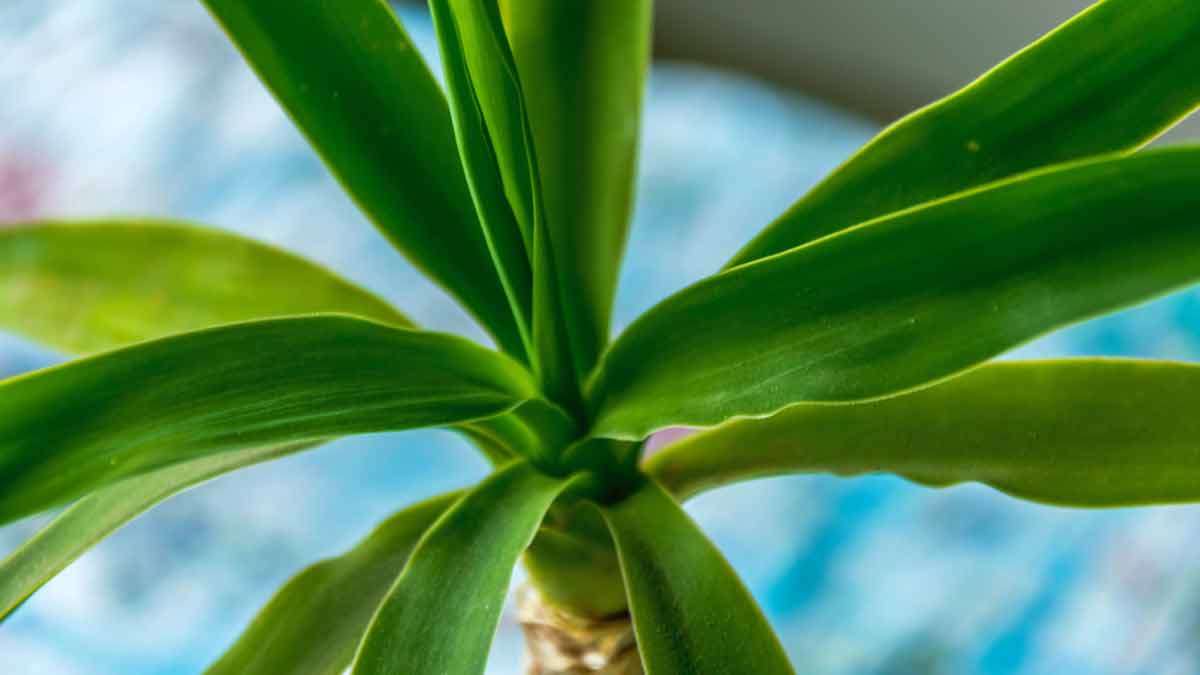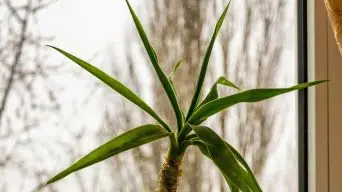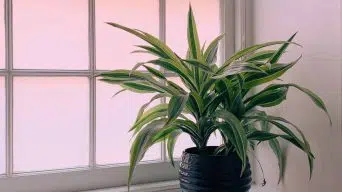Dracaena can be grown hydroponically in water with small pebbles for stability or in vases made for water propagation. Water should be changed weekly or bi-weekly. Dracaena cuttings can be easily propagated in water or soil. It may take a little while for roots to grow.
Dracaena plants have long been popular choices for indoor spaces due to their air-purifying qualities and attractive appearance.
But have you ever wondered if these versatile houseplants can grow in water?
The answer is yes!
Through the process of hydroponic care, dracaena plants can thrive without soil, making them an excellent choice for those seeking low-maintenance options or wanting to explore a new method of plant propagation.
Can Dracaena Grow In Water?
The simple answer to whether Dracaena can grow in water is yes.
This versatile and popular houseplant’s various attractive varieties can adapt well to hydroponic care.
Many plant enthusiasts have successfully propagated cuttings from a dracaena plant directly in water – an easy way for new gardeners to expand their indoor greenery without needing soil.
While growing Dracaena in water offers several advantages, such as lower maintenance than traditional soil-based planting, specific requirements must be met for it to thrive.
These include using clean, filtered water with appropriate pH levels, ensuring proper nutrient availability via fertilizers formulated explicitly for hydroponics use, and closely monitoring light exposure and temperature and humidity conditions.
Advantages And Disadvantages Of Hydroponic Care For Dracaena
As a dracaena owner, it’s essential to understand the advantages and disadvantages of hydroponic care for your prized plants.
The following table highlights the pros and cons of choosing hydroponic care for dracaenas:
| Advantages | Disadvantages |
|---|---|
| Hydroponic systems can benefit the environment, such as reduced water usage and fewer soil contaminants. | Initial setup costs for hydroponic systems can be high, especially if you opt for a sophisticated setup. |
| Dracaena “Janet Craig” and other varieties can thrive in hydroponics, allowing for vigorous and healthy growth. | Some dracaena varieties may not adapt well to hydroponic environments, resulting in slower growth or potential root rot issues. |
| Hydroponic care for dracaenas can result in faster growth rates than traditional soil-based growing. | Managing water quality, pH levels, and nutrient balances can be more involved and time-consuming than conventional soil-based care. |
| Hydroponic systems can be an excellent solution for dracaena owners with limited space or soil-related concerns. | Hydroponic setups require frequent monitoring and maintenance than traditional soil-based growing, including adjusting nutrient levels and pruning. |
Caring for hydroponic dracaenas can be a valuable approach for many plant owners.
However, weighing the advantages and disadvantages is essential to determine if this method is the best choice for your specific plant and situation.
Comparison To Traditional Soil-based Growing
Growing Dracaena hydroponically presents many benefits when compared to traditional soil-based growing methods.
The table below outlines the differences between hydroponic and soil-based growing for Dracaena plants.
| Aspect | Hydroponic Growing | Soil-Based Growing |
|---|---|---|
| Watering | Dracaena plants receive a constant supply of water and nutrients, reducing the risk of dehydration. | Dracaena plants require regular, consistent watering to prevent overwatering and root rot. |
| Nutrient Uptake | Nutrients are directly available to the plant, allowing for faster growth and healthier plants. | Nutrient uptake can be slower, and plants may not receive the exact nutrients they need for optimal growth. |
| Uranium Removal | Hydroponic systems are more efficient at removing uranium from water and soil, as mentioned in the important facts. | Soil-based systems are less efficient at removing uranium when compared to hydroponic systems. |
| Pest Control | Hydroponic systems have fewer pests and soil-borne diseases, resulting in healthier plants. | Soil-based growing can be more susceptible to pests and diseases that can harm the plant’s health. |
| Variety | Many popular indoor dracaena varieties, such as lucky bamboo and Mass Cane, can be grown hydroponically. | While these indoor dracaena varieties can also be grown in soil, they may not thrive as well as in hydroponic systems. |
By understanding the differences and benefits of hydroponic growing compared to traditional soil-based growing, Dracaena owners can decide on the best method to care for their plants.
Container Requirements For Hydroponic Dracaena
Hydroponic Dracaena cultivation’s success depends on the selection of the appropriate container.
A carefully chosen vessel must fulfill two vital criteria: size and depth for optimum growth and appropriate container material to facilitate drainage and support.
Ignoring these key factors could lead to stunted or even dying plants.
Choosing The Right Container
Selecting the right container ensures optimal growth and health for your hydroponic Dracaena.
While any container, from a pretty vase to an old bottle, can be used for water propagation, it is recommended to use a container specifically designed for hydroponics.
A suitable container should have adequate depth and size to accommodate root development without causing overcrowding or waterlogging that could lead to root rot.
Containers made of glass or plastic with clear sides allow you to easily monitor root growth and detect any issues before they become critical.
Size And Depth Requirements For Optimal Growth
Choosing the right container size and depth is crucial to ensure optimal growth for your hydroponic Dracaena.
Fortunately, this is a reasonably straightforward process.
The general rule of thumb is that the container should be at least twice as wide as the root ball, with enough depth to support healthy root development.
A shallow dish or vase can suffice for smaller Dracaena plants like Lucky Bamboo or Janet Craig.
It’s also important to consider the overall height of your chosen container: taller containers provide more support for upright-growing varieties like Corn Plant or Dragon Tree.
Suitable Container Types And Materials
Choosing the right container and materials is essential for successful hydroponic Dracaena care.
Here are some guidelines to follow:
- Glass vases or ceramic containers with a narrow opening work well for lucky bamboo.
- For other Dracaena species, use a mix of potting mix and perlite in a tall, narrow plastic or glass container. Avoid using metal or painted containers as they can leach harmful chemicals into the water.
- The container should have drainage holes to prevent water from sitting stagnant.
- The size and depth of the container should be appropriate for the size of the plant and its root system. A general rule of thumb is that the container should be one-third to half the height of the plant.
- It’s important to remember that as the plant grows, it may need transplanted into a larger container.
Water Preparation For Hydroponic Dracaena
As your Dracaena thrives in its hydroponic environment, every detail counts.
From the purity of the water it receives to the nutrient solutions you provide, each component plays a vital role in its growth and vitality.
It is crucial to unlocking its full potential using clean, filtered water with a pH level between 6.0-6.5 and targeted nutrient solutions tailored to your plant’s growth stage.
Importance Of Using Clean, Filtered Water
Clean and filtered water is essential for successful hydroponic Dracaena care.
Tap water often contains chemicals like chlorine, fluoride, and heavy metals that can harm the plant.
To ensure optimal water quality, it is recommended to use distilled or RO (reverse osmosis) filtered water.
These methods remove impurities from the water and provide a stable pH level suitable for Dracaena growth.
Investing in good quality filtration systems such as activated carbon filters or sediment filters can eliminate harmful elements from your hydroponic system’s reservoir before adding nutrients for your plants’ growth.
Recommended PH Levels For Dracaena Growth
Maintaining optimal pH levels ensures healthy dracaena growth in hydroponic systems.
The recommended pH range for dracaena growth falls between 5.5 and 6.5, with an ideal sweet spot of around 6.0.
It’s important to note that a too-high pH level can lead to nutrient deficiencies, while a too-low level can cause toxicity issues in the long term.
If you’re uncertain about your water’s pH levels, consider investing in an electronic meter or test kit to measure and adjust accordingly easily.
Nutrient Requirements And Fertilizers For Hydroponic Dracaena
Hydroponic Dracaena requires a nutrient-rich solution that provides essential nutrients for optimal growth.
Here are some important things to keep in mind when it comes to nutrient requirements and fertilizers for hydroponic Dracaena:
- The hydroponic nutrient solution must contain nitrogen, phosphorous, and potassium, often called NPK.
- Dracaena plants also need calcium, magnesium, sulfur, iron, manganese, zinc, copper, and boron.
- Mix a good quality liquid houseplant fertilizer at one-tenth of the recommended amount for dracaena plants.
- Do not over-fertilize your hydroponic dracaena plant, leading to root burn or other serious problems.
- It is best to follow the instructions provided with your chosen fertilizer and carefully measure the amount of nutrients you add to the water.
Propagating Dracaena In Water
With its distinctive tall, leafy fronds and hardy nature, the Dracaena plant is popular for indoor greenery enthusiasts.
If you want to expand your collection, propagating Dracaena in water is a simple and rewarding method that anyone can try.
You can create new plants from cuttings and watch them flourish and grow in just a few easy steps.
Steps For Propagating Dracaena In Water
Propagation of Dracaena plants in water is a simple and effective way to increase your plant collection.
Here are the steps for propagating Dracaena in water:
- Cut a stem from your existing Dracaena plant, ensuring it has at least two or three nodes (these are where the leaves grow from).
- Remove the lower leaves from the stem, leaving only a few at the top.
- Place the stem in a jar or vase filled with clean, filtered water. Make sure that at least one node is submerged.
- Place the jar in a bright but indirect light location.
- Change the water every few days to keep it fresh and prevent mold growth.
- Over time, you will notice roots growing from the node(s) submerged in water.
- Once the roots have developed sufficiently (usually after about four to six weeks), transplant your new Dracaena into a container filled with well-draining potting soil.
Timeline For Root Development And Transitioning To A Larger Container
When propagating Dracaena in water, monitoring the timeline for root development and transitioning the cutting to a larger container at the appropriate time is crucial.
Typically, roots will begin to sprout within 2-3 weeks after placing the cutting in water.
It’s important not to rush this process, as rushing can damage fragile roots and stunt growth.
If you notice that your cuttings are taking longer than average, don’t panic, as some species of Dracaena take longer than others to develop roots.
Common Mistakes To Avoid When Propagating In Water
Propagation in water can be an effective way to grow new Dracaena plants, but it is important to avoid these common mistakes:
- Using unsanitized equipment – Sterilize any cutting tools, containers, and water before propagating your plant in water.
- Leaving the cutting submerged for too long – While it may seem like leaving the cutting in the water longer will promote root growth, it can lead to root rot or mold growth. Ideally, only leave cuttings in water until they develop roots at least an inch long.
- Overcrowding the container – Propagation containers should have enough space between cuttings to establish roots without being too close together.
- Using tap water without treatment – Water containing high levels of minerals or chemicals can harm young Dracaena plants, so it is best to use purified or distilled water when propagating in water.
- Not changing the water regularly – To prevent stagnation and bacterial growth in the propagation container, change the water every few days and rinse off any debris or discoloration from the stems or leaves.
Care And Maintenance Of Hydroponic Dracaena
A thriving hydroponic Dracaena is a result of meticulous care and attention.
Its growth is contingent on a delicate balance of optimal light exposure, precise temperature, humidity control, and monitoring of regular nutrient and pH levels.
Pruning and repotting also play a vital role in maintaining its health.
Light Requirements For Hydroponic Dracaena
Hydroponic dracaena plants have specific light requirements that differ from those grown in soil.
They thrive in bright, indirect sunlight and should be placed near a window or under grow lights for at least six hours daily.
Direct sunlight can scorch the leaves of dracaenas, so it’s best to avoid exposing them to direct sunlight.
If your home doesn’t receive adequate light, consider investing in artificial lighting, such as LED grow lights, to provide the necessary light intensity and spectrum.
It is essential to closely monitor your hydroponic Dracaena’s growth progress by examining any discoloration or brown tips on its leaves that may indicate problems with lighting conditions.
Different varieties of Dracaena require varying amounts of light, so knowing what type you’re dealing with is crucial before you start growing them hydroponically.
Temperature And Humidity Considerations
Temperature and humidity are crucial aspects to consider when caring for hydroponic Dracaena.
These plants thrive in temperatures ranging from 70-80°F during the day and around 60-65°F at night.
High humidity levels between 50-70% should be maintained, especially for Dracaena Marginata, which is sensitive to dry air conditions.
If your home environment is too dry, use a humidifier or place a tray of pebbles filled with water under the plant’s container to increase moisture levels.
Maintaining optimal temperature and humidity ensures that your hydroponic Dracaena thrives and prevents problems like leaf drop or brown tips caused by heat stress or lack of moisture.
Monitoring And Adjusting Nutrient Levels And PH As Needed
In hydroponic care for Dracaena, it’s important to keep track of the nutrient levels and pH of the water solution.
The pH level plays a significant role in controlling plant nutrient uptake through their roots.
Additionally, monitoring the nutrient levels is necessary as different stages of plant growth require varying amounts of essential elements such as nitrogen, phosphorus, and potassium.
By closely monitoring these variables and making necessary adjustments, you can ensure that your hydroponic Dracaena thrives in its environment while avoiding issues such as yellowing leaves or root rot often caused by imbalanced nutrient concentrations.
Pruning And Repotting Tips For Healthy Growth
To ensure that your hydroponic Dracaena plants thrive, it’s essential to prune and repot them regularly.
Here are some tips for healthy growth:
1. Pruning
- Only prune when necessary, and always use sharp, clean tools.
- Remove any yellowing or dead leaves to promote new growth.
- Cut back leggy stems to encourage bushier growth.
- Remove any diseased or damaged foliage immediately to prevent the spread of infection.
2. Repotting
- Choose a container that’s slightly larger than your current one.
- Use a well-draining potting mix or hydroponic medium for optimal growth.
- Gently remove the plant from its old container and loosen any tangled roots before placing it in the new one.
- After repotting, ensure thorough watering for the plant, but exercise caution to prevent overwatering, as it may result in root rot.
Final Thoughts
Hydroponic care is an excellent option for dracaena owners who want to try something new.
Dracaena can grow in water and thrive with proper container requirements, clean water preparation, and monitoring of nutrient levels.
Propagating Dracaena in water is also possible with the right steps and care.







